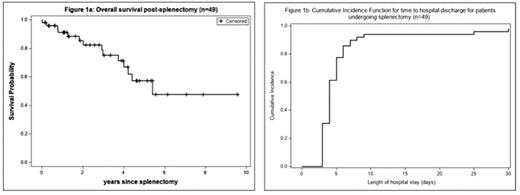Abstract
Introduction: Splenic B-cell lymphomas are rare and understudied entities. Over the past decade, outcomes of splenectomy for patients with splenic marginal zone lymphoma (SMZL), hairy cell leukemia variant (HCLv), and splenic diffuse red pulp lymphoma (SDRPL) have not been studied in the United States outside of the SEER database. Splenectomy is still required for a definitive pathological diagnosis in many patients with splenic lymphomas other than classical hairy cell leukemia (cHCL). In addition, splenectomy can be effective therapy with durable responses. Our study aimed to investigate the diagnostic and therapeutic role of splenectomy for indolent splenic B-cell lymphomas other than cHCL.
Methods: All patients who underwent splenectomy between 1 August 2011 and 1 August 2021 (n=87) were identified using pathology records and the Wilmot Cancer Institute (WCI) lymphoma database at the University of Rochester Medical Center (URMC). All patients in the database with a clinical diagnosis of non-cHCL splenic B-cell lymphoma who did not undergo splenectomy (n=20) were identified to obtain a comparison cohort. Information abstracted from the medical records included the sociodemographic data, date of diagnosis, treatments utilized, and complications of splenectomy. Follow up continued until the last documentation of medical intervention available.
Results: Forty-nine patients (median age 68 years; IQR: 64-75) who underwent splenectomy had a splenic B-cell lymphoma other than cHCL (SMZL n=33, HCLv n=9, SDRPL n=7). Median follow up was 3.9 years and median overall survival (OS) was 5.4 years (95% CI: 4.0, not estimated) (Figure 1A). Splenectomy was tolerable except for 1 patient who had fatal post-operative complications. Patient post-operative hospital discharge was within 4 days for 61.2% (95% CI: 46.0%, 73.4%) and within 10 days for 93.9%, (95% CI 80.8%, 98.2%) (Figure 1B). Splenectomy alone was first line therapy for 25 patients. Splenectomy resulted in a change in lymphoma diagnosis in 5 (26.3%) of the 19 patients who underwent splenectomy after initial medical therapy. To compare the outcomes of first line management with splenectomy versus medical therapy, we identified all patients with a presumed diagnosis of a splenic B-cell lymphoma other than cHCL who never had a splenectomy (n=20). Of these patients, 11 remained on observation and 9 required medical treatment. The five patients who had first line splenectomy followed by rituximab therapy as initial therapy were excluded from this comparison. Subsequent treatment for progressive lymphoma was required in 3 (33%) patients initially treated medically compared to 4 (16%) patients undergoing initial splenectomy. Of the 7 patients diagnosed with SDRPL by splenectomy, 5 remained in complete remission after surgery.
Conclusion: Splenectomy is an important method for the diagnosis and treatment of splenic B-cell lymphomas with comparable risk/benefit profile to medical therapy and the potential for durable remission. Splenectomy resulted in a change in lymphoma diagnosis in 26% patients after failure of initial medical treatment. Our data suggests that patients with splenic lymphomas other than cHCL should be considered for diagnostic and therapeutic splenectomy at a high surgical volume center with experience in performing splenectomies.
Disclosures
Evans:Acerta/AstraZeneca: Research Funding; TG Therapeutics: Research Funding. Zent:TG Therapeutics: Research Funding; AstraZeneca: Research Funding.
Author notes
Asterisk with author names denotes non-ASH members.


This feature is available to Subscribers Only
Sign In or Create an Account Close Modal